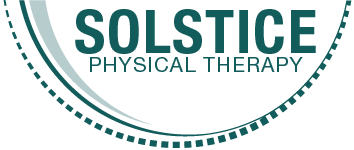Rotator cuff tear? See a PT first!
The shoulder is an amazing joint in that is has motion in so many directions, can bear a lot of weight for being such a small joint and the only attachment to our skeleton is through the sternoclavicular joint (where your collarbone attaches to your breastbone). The socket of this ball-and-socket joint is extremely shallow and small in comparison to the larger head of the humerus (the upper arm bone). Imagine a golf ball (your upper arm bone) sitting on a golf tee (the socket of the shoulder blade). So you may be thinking…how in the world does my shoulder stay attached? It’s main stability is muscular! The actual ball-and-socket joint is surrounded by a capsule that is made of very dense connective tissue and this helps to stabilize the joint directly, but the shoulder blade, collarbone and upper arm are mostly stabilized and controlled by muscle. The rotator cuff is the deepest and most important part of this muscular group when it comes to control of the shoulder during movement. Then you’ve got all of the bigger muscle groups on top of that such as the deltoid, bicep, tricep, pectoral muscles, latissimus dorsi, serratus anterior, rhomboids, trapezius and levator scapulae. You almost never hear about people tearing these larger muscles (with the exception of the bicep), but the rotator cuff is very common to injure or tear and can lead to significantly decreased function of your arm.
Rotator cuff tears tend to have many specific signs and symptoms and a physical therapist can complete a musculoskeletal evaluation to determine the likelihood of you having a tear. It is difficult to completely determine the extent of the tear from the evaluation unless it is a complete tear, as some people have developed ways to compensate or are in so much pain that every test hurts badly and it is difficult to tell what is the causative factor of their pain. An MRI is the best way to determine the extent of a rotator cuff tear without actually completing a surgery. The only issue with MRIs is that sometimes it is difficult to tell how bad the tear is and sometimes once they get into the area during a surgery they realize that the damage is much worse than what could be seen on the MRI.
Having a rotator cuff tear does not mean you need surgery!!! Woohoo!! Even if an MRI shows a definite rotator cuff tear, surgeons will almost always recommend conservative therapy if it is 50% or less and even larger tears are often treated successfully with therapy. Surgery can be very invasive and the rehabilitation afterwards is very long and painful. It is always recommended that people try physical therapy for at least 6-8 weeks before deciding to take the surgical route. It is very unlikely that therapy will cause a tear to worsen, but having surgery increases the risk factors for poor healing by a large margin. Many times, a rotator cuff tear comes on gradually from repetitive motion, poor posture and degeneration. In this case, the tissue quality is poor and the surgeon has very little to work with (tissue can be very thin and shredded), which can lead to a poor surgical outcome and a very high risk for re-tear. The other issue is that no matter how good the surgeon is, the repair will never be the same as the original and this can lead to poor biomechanics, compensation and lingering pain and dysfunction.
Physical therapy works to initially decrease pain and inflammation, improve blood flow to the area to stimulate healing, restore full range of motion and then gradually work back into a strengthening and functional exercise program to restore full function. In my practice, I include dry needling and cupping, as my gentle technique can really help to bring blood flow and healing nutrients to the area. Often, rotator cuff tears occur because of precipitating factors such as postural deficits, decreased range-of-motion and muscle tightness, poor flexibility or strength imbalances. Through physical therapy we find these deficits and show you how to improve them through flexibility, strengthening, core and awareness exercises and education. Often once we remove the source of the problem (posture, tightness, etc) the rotator cuff is no longer being irritated and people are able to return to their normal activities without pain.
If you have shoulder pain, please see a physical therapist! We can complete a full evaluation to determine the most likely source of your pain and then evaluate the causative factors and show you how to eliminate them. If you are in the Denver Metro area, please contact me at info@solsticehealthcareresources.com or check out my website at www.SolsticePhysicalTherapy.com.

